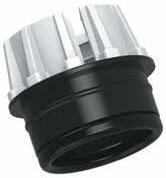







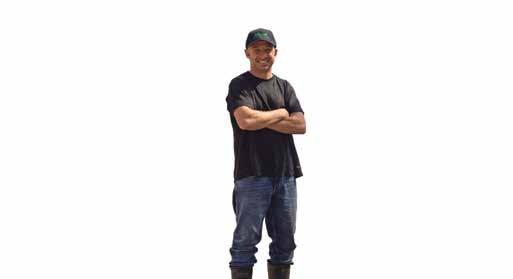

Farmers who have predominantly used LIC genetics over the last 10 years have doubled the rate of genetic gain in their herds. Greater application of genomic technology in our breeding programme, alongside farmers’ sharper focus on herd improvement, have been key contributors to the faster rates of genetic improvement we’re seeing.
Breed your herd, your way. Accelerate genetic gain with our top-performing Premier Sires® teams, generate more heifer replacements with sexed semen or focus on animal health by choosing bulls bred to be more resistant to facial eczema. Consider beef genetics to broaden your revenue options and short gestation length semen to condense calving.
So, continue setting yourself up for success with a strong breeding plan. Talk to your Agri Manager today or visit lic.co.nz

There's always room for improvement



SUDESH KISSUN sudeshk@ruralnews co nz
DESPITE THE turmoil in global markets, Fonterra is continuing with a dual track process to divest its multi-billion dollars consumer businesses.
A co-op spokesperson told Dairy News that it will continue to assess market conditions as the process evolves.
The co-operative is considering both a trade sale and an initial public offering (IPO) for the businesses, which include household name brands such as Anchor and Mainland as well as the Fonterra Oceania and Fonterra Sri Lanka operations. If the for-sale assets are to be listed on the stock exchange, it will be under the name of Mainland Group.
However, as countries grapple with President Trump’s onagain, off-again additional import tariffs, several US companies have paused their initial public offerings in recent days including UKbased Klarna, the specialty lending and online payments provider, and online ticketing company StubHub. Both were set to list on the New York Stock Exchange. Global markets are spiralling, with US indices marking their worst losses since 2020. Global business analysts fear it would be very tricky to get any deal to the finish line as cost of debt is expected to go up and it will be harder to ascertain valuations of companies.

Forsyth Barr senior equity analyst, Matt Montgomerie believes the market turmoil should have a negligible impact on Mainland Group’s direct operations.
However, he agrees that there is downward pressure on valuations, and this could impact Mainland if Fonterra chooses the IPO option.
“The market turmoil is clearly in the face of tariffs along with global and US economic growth fears,” Montgomerie told Dairy News
“In reality, this should have a negligible impact on Mainland’s direct operations.
“This said, at this point there is clear downward pressure on valuations. The valuation impact could flow through to Mainland if it is to be an IPO candidate, but the world is evolving at a rapid pace currently,
so this is difficult to call at this juncture.”
Montgomerie points out it will still be some time before the IPO option is finalised. “While it could be considered by Fonterra, this is not our base case,” he adds.
Fonterra Oceania is a fully integrated business, recently created through merging Fonterra Brands New Zealand and Fonterra Australia. It comprises consumer, foodservice and ingredients businesses.
Fonterra Sri Lanka comprises consumer and foodservice businesses.
Fonterra says it would seek votes from farmer shareholders for their preferred divestment option before deciding.
Montgomerie doesn’t think the recent turmoil would’ve altered the trade sale vs IPO probabilities to any
great extent.
“The trade sale will come down to the opportunities prospective buyers see to create value above what Fonterra has failed to deliver – whether that is through cost synergies or a sharper focus on the brands.”
He adds that the ‘in-scope’ or Mainland EBIT growth for first half of 2025 was +16% compared to same period last year.
“If these growth rates can be held for the remainder of FY25, this represents an FY25 Mainland Group EBIT of $231m, which would likely be at the upper end of what it has delivered historically.
“So, while valuations are down from recent peaks, Mainland Group earnings versus history are relatively well placed.”

MUCH-NEEDED RAIN
finally arrived in Northland, giving many farmers breathing space to get themselves back on track for next season.
Dargaville farmer
Baden Bickers’ farm received over 80mm of rain earlier this month and he believes the drought is over. The rain also means Bickers can continue milking rather than drying off the cows a month earlier.On April 1st came the warning that an ‘atmospheric river’ and potential drought breaker was about to hit the country. The next day there was drizzle and then the following day the rain arrived with a vengeance.
Bickers is a thirdgeneration dairy farmer
near Dargaville, one of the worst hit parts of the Far North. He milks 650 cows once a day on a 270ha milking platform plus support blocks. For him the rain over three days was pretty much a drought breaker.
“Things are greening up already. Now that it’s rained, we have some maize paddocks and weeds will germinate, and we will give them a spray and get the grass in while the soil is moist,” he told Dairy News.
“I think we will recoup a bit at the end of the season rather than just winding up as we would have in another few weeks,” he says.
Bickers says droughts are the norm in Northland but some are worse than others and this was a bad one. He says water levels in his dams that provide stock water were

getting very low and he was having to feed out supplements to keep the herd going. He says they were close to having to dry cows off a month earlier than normal and cull some.
Bickers says the drought will affect production but adds that before the drought
struck, his production was up by 10%.
“Just looking over the fence you could see everyone running around with silage wagons and trucks and trailers carting bales.
“We were quite fortunate in that we made 1600 bales of grass silage and had a reasonable
crop of maize which we harvested recently. We fed out a lot of supplement and bought in some PKE to help until the rain arrived,” he says.
Bickers worries for farmers who have been using a lot of supplement that would normally be saved for winter. He says he worries about some
DURING HIS dairy farming career, Baden Bickers has tried a range of options At one point, he autumn milked a third of his herd way twice a day But 10 years ago, he decided to go once a day milking (OAD) and hasn’t looked back since
He says he took a production hit initially, but after about three years things went back to a sort of normal with production coming back as cows adjusted to the change He notes that a lot of other farmers in the district are also milking OAD
The other change that has been forced on him and other dairy farmers is the compliance issues which take up a lot of time At present he employs a contract milker who in turn employs two staff He says it’s nice not having to worry about staff and just focus on “doing stuff”
As the only son, Bickers took over the farm from his parents, but says that if he’d had a brother, more than likely the brother would have been the farmer “At school I enjoyed technical drawing and probably would have ended up being an architect As it stands, I designed and built a new dairy shed and the new house for my wife and four kids,” he says
of the young and inexperienced farmers who have never been through a drought like this. He also fears for some older
THE ‘ATMOSPHERIC river’ of rain that swept down the country last week almost completely avoided one of the worst drought-affected regions in the country – coastal Taranaki.
Federated Farmers dairy chair for Taranaki, Sam Ebbett, told Dairy News that while it was reported that over 400mm of rain fell in the province, most came down in areas around and inland from Mt Taranaki. He farms around the township of Ingle-
wood and got about 150mm of rain.
“But further south in the areas that needed the rain most – places such as Hawera, Manaia and Pihama – got a paltry 20mm or 30mm of rain.
This was barely enough to wet the ground and start things growing, but it’s by no means a season saver,” he says.
The reason for coastal Taranaki missing out on the downpours that came in other regions is because of
the role that Mt Taranaki plays in the climate. Ebbett says with the big weather system coming from the north, the mountain deflects the rain away from the coastal areas and into areas further inland. He says the prediction in the coming weeks is for a more westerly flow and this may bring rain to the coastal areas where the rain is needed most.
“Those farmers need about 40 or 50mm of rain for each of the next

three weeks to get back on their feet,” he says.
Ebbett says he’s only farmed in the province for about 10 years but says the old-timers who have been around forever say this is the worst drought in 80 years.
He says many farmers have used up a lot of the supplements that were destined to get through winter; now more feed is being trucked into the region. Ebbett says even those farm-
farmers who have not learned how to manage their way through a drought like the present one.
ers like himself who haven’t been affected by the drought are tight on feed. He says many farmers are drying their herds off early to protect the next season.
“A big focus for us at Feds is looking after contract milkers whose herds have had to be dried off. They are facing the prospect of having no income until August and that is very stressful and worrying for them,” he says.


DAIRY FARMERS will be paying a new levy rate of 4.5c/kgMS – an extra 0.9c/ kgMS – to industry-good body DairyNZ from June 1 this year.
DairyNZ chair Tracy Brown told Dairy News that the new rate, approved by the board, strikes a balance between “a broad spectrum of farmer views” received during a month-long consultation process.
Brown notes the board has also given farmers some certainty by aiming to keep hold the levy “at no more than this rate for a minimum of three years”. “Board members read every piece of submission from farmers and thought long and hard before settling for 4.5c/ kgMS,” she says.
The current rate of 3.6c/kgMS was set when DairyNZ was established 16 years ago. The new rate would increase a farmer’s annual milksolids levy payment by $800 per 100,000 kgMS.
The levy rate is different to the six-year milksolids levy vote during which farmers vote on their continued support for DairyNZ. This will take place next year.
Brown says she was happy with consultation process that included 12 events and attracted feedback from 1588 farmers, representing 18% of total milksolids.
“The consultation was held in February – a busy period on the farm and many farmers were grappling with effects of the drought,” she says.
“I’m really grateful that they came and engaged with us.”



Brown says the 18% turnout by milksolids “is similar to the turnout during director elections”.
The new rate will allow DairyNZ to continue supporting the country’s dairy farmers to lift profitability and sustainability through science and research, policy advocacy and extension behind the farm gate.
“Some farmers

endorsed our work and want us to do more, especially across science and research, while others wanted a stronger commercial focus to keep costs down, or the levy rate to remain unchanged,” says Brown.
“In making the decision, the board carefully considered the feedback, how best to support farmers and provide certainty into the future, the

AT THE new levy rate, DairyNZ will maintain its focus on three strategic priorities over the next three years: accelerating on-farm productivity, powering more adaptable and resilient farms, and enabling sustainable and competitive dairying
In line with its strategy reset last year, DairyNZ is working with partners to reduce duplication, strengthen policy advocacy to ensure practical and enduring settings for farmers, deliver smarter, targeted science by focusing on applied research that provides on-farm benefits, and rolling out improved extension events
DairyNZ says its management team continues to apply a more rigorous commercial focus across the organisation, including cutting costs by $5 5m in the past year and refocusing efforts on high-value projects
The industry-good body passes on 0 8c/kgMS from the levy to the Tb free programme
financial sustainability of DairyNZ, and sector resilience.
“Importantly, I want farmers to know that we’ve heard their feedback on areas important to them. We will deliver
improvements including in farmer engagement, transparency around levy spending and return on their investment, and our science and research programme to keep the focus sharp on productivity, resilience

and sustainability.”
She says DairyNZ is the only organisation that supports dairy farmers with independent scientific research for the sector alone.
“Therefore, we’re committed to delivering the right science in the right way on-farm and proving its value every step of the way.
“Our vision is to ensure the levy is the best investment of every New Zealand dairy farmer. This commitment underpins everything we do. We will share more details about these improvements over the coming months.
“Dairy farmers can be confident DairyNZ will continue to back them with the right tools and support to ensure they have a positive future and can grow their businesses.”


























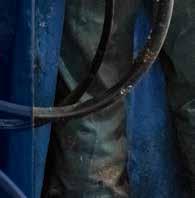

FOR SOME Canterbury teenagers, their career journey is being shaped by hands-on experience in a sector they are passionate about – dairy farming.
The NextGen Dairy Farmers pilot programme, launched last year by Dairy Training, a subsidiary of DairyNZ, includes a three-week pre-employment training, followed by six months of on-farm employment with weekly training sessions, and ongoing pastoral care and support for budding dairy farmers.
Matthew Fox, 18, a 2024 graduate of Lincoln High School, was eager to find his next opportunity when he discovered the NextGen Dairy Farmers pilot programme.
“I wasn’t raised on a farm, but my grandparents do mixed farming with sheep and crops, and my aunt owns a dairy farm, so I’ve had some exposure,” Fox explains.
“This made me realise that I wanted a career outdoors, which is what attracted me to farming.”
Enthusiasm is the necessary precursor to experience, Fox points out.
“I really enjoy seeing the animals happy, and knowing I’m part of New


Zealand’s primary sector,” he says.
“My host farmers are dedicated to teaching me, taking the time to explain things, and providing feedback when I need to improve. It’s a supportive learning environment.”


The NextGen programme is a NZQAaccredited initiative aimed at Year 12 and 13 school leavers, providing a solid foundation for a successful career in dairy farming. It is one of seven training courses offered by Dairy Training, the others focused
on enhancing the skills of workers already in the sector.
The programme has proven valuable for Fox.
“The training days not only focus on farm skills but also teach us about financials, wellbeing, and how other farms operate – knowledge I can apply later in my own career.”
Host farmers Becs and Josh Dondertman employ Fox at a Dairy Holdings farm near Dunsandel, Canterbury, where they milk 1100 cows.
Becs has been influential in shaping the Next-
Gen programme, working with other local farmers and Dairy Training to create an effective learning experience for new entrants into the dairy sector. Dairy Holdings also provides support, information and industry knowledge, which helps support programmes like this, and farmers new to the sector.
“Josh and I have always been keen to help people develop. People have helped us through our career, and we want to return this by supporting others in their careers
HAMISH HODGSON, head of Dairy Training, emphasises that this programme was designed based on farmer feedback, with pre-employment training focused on what farmers believe new entrants to a dairy farming career should know
“We set out to see how we can promote pathways into dairy from high school, and we formed this programme concept alongside farmers It was important to ensure that students are set up for success, both on and off the farm,” says Hodgson
“Dairy Training Limited is focused on offering practical, easy-to-access training that is designed with dairy farmers, for dairy farmers, to support the long-term success of our sector We have seen this approach to training go from strength to strength, with course enrolments having increased by 500% over the past 5 years ”
Applications for the next intake of the NextGen Dairy Farmers programme are now open, with applications closing on May 30
The programme is seeking Year 12 and 13 students interested in pursuing a career in dairy farming, as well as host farmers in Canterbury willing to support the development of future dairy farmers
too,” says Becs.
“The dairy sector is no different to many sectors that struggle to attract and retain young people.
Part of our ethos is that we don’t believe you can be frustrated about something if you’re not willing to try being part of a solution.
“This programme is a trial, but it is a possible solution to a challenge dairy faces, and we don’t know how it will work if we don’t try.
“I’m excited and hope
more farmers put their hand up this year, to be a host farm and help provide more opportunities for students to join the programme.
“If we invest this money into the next generation of farmers like Matthew, and at the end of the 6 months they still enjoy farming and want to continue, then we have a fulltime employee, and that investment was worth it.”
@dairy_news facebook com/dairynews
AFTER 20 years of milking cows, Northland farmer Greg Collins is ready to step into the governance side of dairy.
The Fonterra Co-operative Council member and Northland Dairy Development Trust trustee joins the DairyNZ board as associate director from June 1.
“I was over the moon to find out I had been chosen for the DairyNZ associate director role,” Collins says.

“It will be a huge opportunity for me, and getting my feet under the table of a board like DairyNZ will be an invaluable experience.”
Collins and wife Claire, own a dairy farm in Dargaville, Northland, milking 140 cows
The couple’s commitment to improving environmental outcomes was recognised with a Northland Ballance Farm Environment Award in 2024, along with an award nomination in this year’s New Zealand Dairy Industry Awards.
DairyNZ associate directors are non-vot-
ing roles, appointed for a oneyear term. The role supports emerging leaders and those currently contributing to the sector, by providing experience and support from the eight current DairyNZ board members, which can help in future governance roles and opportunities.
Fourteen other farmers have held the role since the initiative was introduced in 2013.
“After 20 years of milking cows I’m ready,” says Collins.

enthusiasm, experience, and interest in the sector will be an invaluable asset to the board.
“Greg has a deep commitment to sustainability and innovation, and a wealth of experience that will help bring a different perspective, and unique insight to our discussions,” says Brown.
“It will be another busy year for DairyNZ, and Greg, as part of the DairyNZ board, will contribute to our important work of supporting New Zealand dairy farmers.”
“Things in our industry are constantly changing, and we need to be well-placed to deal with future challenges. That’s why it’s so important to have an organisation like DairyNZ at the forefront.”
DairyNZ chair Tracy Brown says Collins’
She thanked current associate director Jonathon Hoets for his work over the past year.
“Jonathon has made a considerable contribution during his time on the board, and we wish him well for the future.”
FONTERRA SAYS it takes the ongoing threat of ‘adverse cyber action’ extremely seriously.
“We have a range of measures in place to keep the co-operative and our data environment safe,” a spokesman told Dairy News.
However, the co-operative did not say whether it has ever been on the receiving end of a cyberattack, either here or overseas.
THE KORDIA report reveals the extent to which AI is reshaping behaviours and attitudes around cyber security for New Zealand businesses, as well as the evolving nature of cybercrime
“AI-generated cyber-attacks are the new frontier of cybercrime,” explains Alastair Miller “The democratisation of increasingly sophisticated AI technology has catapulted the effectiveness and speed of cybercrime to extraordinary new heights ”
Miller points to the recent uptake of large language models in AI-generated phishing attacks as an example Not only has it enabled greater personalisation and adaptability by mimicking writing styles or contextualising messages in a timely manner, but it’s also enabled greater levels of automation, resulting in a highly scalable and incredibly efficient tactic for cybercriminals
Of the 59% of respondents who said their business suffered a cyber-attack or incident in 2024, 43% of those were compromised by an email phishing attack
The co-op’s comments follow independent research from Kordia that revealed that 28% of New Zealand large organisations consider AI generated cyber-attacks to be a top threat to their businesses, despite only 6% of cyber breaches being attributed to an AI-generated attack.
“Those numbers are high, and we know that they can be attributed in large part to a rise of AI-generated cybercrime tactics ”
State-owned enterprise Kordia surveyed

investment needed by cybercriminals to craft, refine and adapt social engineering campaigns. As a result, we’re seeing a surge of businesses reporting attacks involving sophisticated email phishing, something that we expect will continue to increase.”
lion ransom in Bitcoin to resolve the issue.
Miller says Kordia’s survey reveals that financial gain is a clear motivator behind attacks on Kiwi businesses.
295 businesses with more than 50 employees as part of its annual New Zealand Business Cyber
The report shows that almost two thirds (59%) of New Zealand businesses were subjected to a cyber-attack or incident in 2024, 43% of all cyberattacks and incidents were caused by email phishing and almost 1 in 10 businesses compromised by a cyber incident paid a ransom or extor-
Alastair Miller, principal security consultant at Kordia-owned Aura Information Security, says the findings reflect the proliferation of AI technology, resulting in an increase in social engineering and phishing attacks against businesses.
“AI has lowered the cost of entry and time
Agribusinesses around the world have been targeted by hackers. One of the biggest cases involved the world’s largest meatpacking company, JBS Foods. A ransomware attack in May 2021 halted operations at 47 sites in Australia and nine in the US for five days. The shutdown threatened meat supply chains, with temporary staff layoffs at some plants and reports from farmers that their shipments of livestock were cancelled. JBS Foods paid an $US11 mil-
“Money is the motivator. That’s why it’s unsurprising to see stolen personal information, IP, commercially sensitive data and business disruption, amongst the list of impacts faced because of a cyber incident. These are all things that cybercriminals can leverage to put pressure on businesses to pay a blackmail or extortion demand,” Miller says.
The report notes that despite this, many of the businesses surveyed are still not implementing basic cyber security, or elevating cyber security as a top risk for the company’s board.

Getting in early is always a good thing. Order your Allflex tags before 30th April and we’ll pay the NAIT Levy. A saving of almost a dollar a tag! (Actually $0.97 plus GST if you want to crunch the numbers).
The saving applies to the entire range of Allflex NAIT-approved cattle tags (including eID Calf packs, Birth eIDs and Replacement eIDs).
If you’re running large numbers of stock that can add up to a handy discount. So get your order in today and be the early bird that wins... Just another reason why you should always ask for Allflex.
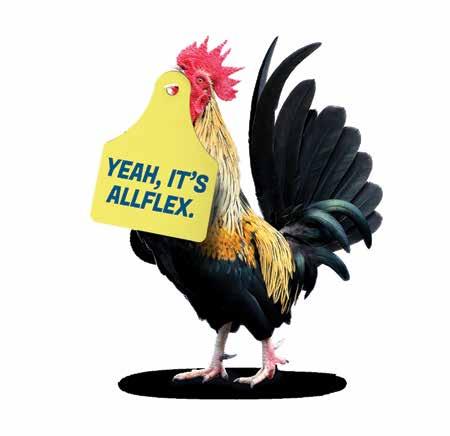
Order your NAIT cattle tags between 6 January 2025 and 30 April 2025 and Allflex New Zealand will discount the order to the value of the applicable NAIT levy ($0.97 plus GST per tag).*
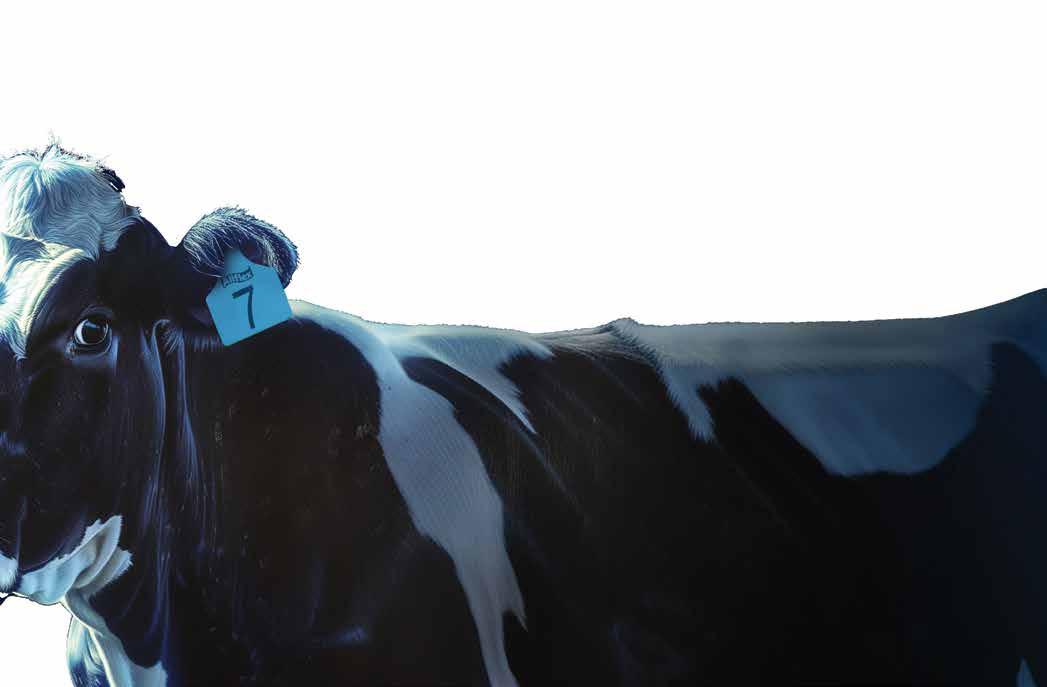
Everyone from experienced veterinarians and young professionals to the Wormwise programme and outstanding clinics have been recognised in this year’s New Zealand Veterinary Association (NZVA) awards. As part of a series looking at this year’s rural winners, Leo Argent talked with Neil Chesterton, winner of the Veterinary Impact Award for his work on lameness in cattle and cow psychology.
How did you get started as a vet?
I did my vet science course at Sydney University. Me and my future wife Sandra were city people and when I finished the course the thing that really interested me was dairy cows. One of my lecturers saw my interest and he said, ‘Go to New Zealand, they have much more dairy cattle than Australia’. He joked that I should go for three years, make all my mistakes then come back as an overseas expert. To make a long story short, Sandra and I married just after my course finished then we packed our bags and came to New Zea-
land. Fifty years later, we’re still in the same town [Englewood] and I was in the same practice up until retirement. When I first came it was mixed practice with about four vets. Dairy cattle were 70% of the work but we still did cats and dogs. As the practice grew I did less of the dogs and cats and more and more of the dairy cattle.
What made you decide to focus on lameness in cattle as one of your career specialties?
We were always getting lame cows here. However, all the literature I read on the topic was from the Northern Hemisphere, indoor
cows in big barns. People were thinking that’s what causes lameness in NZ and I realised that something different was going on here. I knew how to treat them, but I didn’t know what caused it. Right at the beginning there were two farms next to each other, identical setup, but one had lots of lame cows, the other hardly any. I started looking into what is the one farmer doing that the other isn’t and so began my inquiry. What I learnt from those farms, I then thought I’d set up some proper experiments. I contacted all the vet practices in Taranaki, and I ended up doing 60 farms

all together. I wrote up a list of all the questions I had from the high and low lameness farms, and I wrote the answers down. What were the main
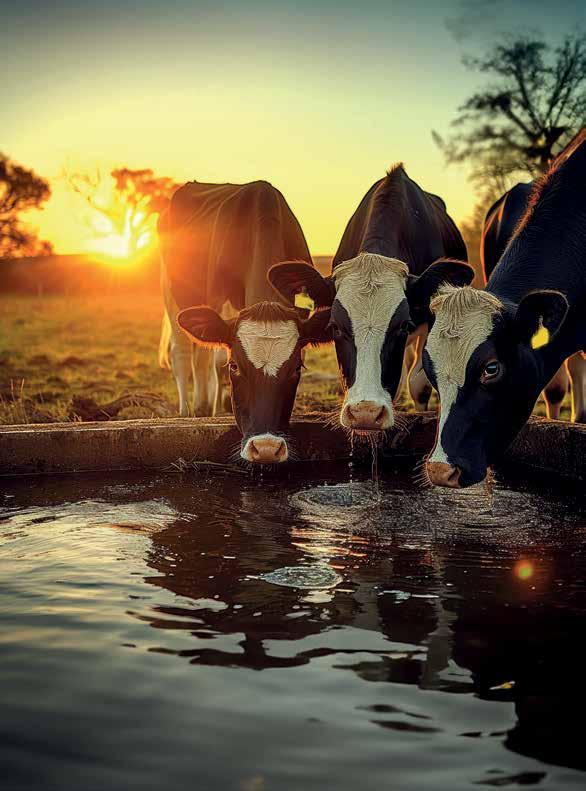
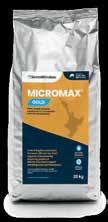
Not getting trace elements right in your herd’s diet can lead to serious consequences - lower fertility, lost days in milk, and reduced productivity. Don’t wait until it’s too late! Talk to our Nutrition Specialists today about Micromax.

differences between the Northern Hemisphere systems and our systems?
Because they’re mostly inside on concrete and on feed pads the farmer must decide on nutrition and feed for his cows, while our cows ate grass. They were blaming nutrition and the design of rubber mats where cows slept on concrete. They had injuries which we hardly saw, such as solar ulcer. Even that difference in the injury percentage and types made me think there’s something different going on in New Zealand. How cows walk to the milking shed in New Zealand was one of the factors, with longer tracks having slightly more lameness. What’s the difference between tracks? How wide is the track for the herd and what is the track made of?
What is some advice regarding lameness in cattle that farmers should know?
Lameness mainly happens in the walking track and cowsheds. When you come with your cows, keep 10ms behind the back cow as they come to the shed. At 10m cows are not afraid of you so they walk naturally, looking where to put their feet. When the cows come into the yard don’t touch the back gate for at least 20 minutes. That allows the cows to shift from arrival to milking order; give them time to change. Then you may need to move your gate
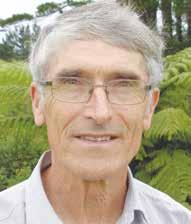
up but only move it a metre at a time to walk the cows up, not push them. Some farmers don’t even move them, just open the gate a bit earlier and let them come voluntarily. The cows just come in, get milked and go back to pasture. You get a farmer to do that and there’s less lameness.
How intelligent do you think cattle are?
Cows are amazingly intelligent. They recognise people. If you have changeover of staff and they don’t know a person, that person must be even more gentle and quiet with the cows.
What are some common mistakes people make when dealing with cattle on a psychological level?
Trying to rush the cows when coming home and entering the cowshed. Some people try to use the backing gate to put pressure on. Some have electrified topgates. The people who don’t understand cows use those too much. The other thing is moving too fast. Don’t go shouting at cows, whistling too loud, tapping the bars ‘bang, bang, bang’.
What are some tips to improve cattle behaviour?
Most of the fear they have of someone is when that person gets too impatient, putting pressure on them. If I come in and try to move the
back ones, those cows are pushed in among more dominant cows who beat them up. The main thing is to keep distance and allow them to flow at their own pace. In the end, milking becomes quicker as they’re not afraid.
What is your proudest accomplishment in the industry?
Seeing struggling farms that had such a problem with lameness become such a different farm when they don’t have lame cows. Is there anyone you’d like to shout out to having won this award?
When I first came here, I was a new graduate, a townie in a country practice. My original boss Gunner Groenbrek trusted me with my cause and gave me such support. Ray Paewai joined at the same time as me, but he was an experienced vet. As my interest in lameness got more and more, he allowed me time that I could spend on my specialty and investigate lame cow problems. I was able to leave the practice, and he organised others to do my general practice work. I don’t know any practice that I could do that in now.
farmer and rural advocate
THREE FARMERS
making contributions to the wider dairy sector have been chosen as this year’s finalists for the prestigious Fonterra Dairy Woman of the Year title.
Frances Beeston, Jo Sheridan and Lara Sutton have been selected to compete for the title by a judging panel comprising Dairy Women’s Network (DWN) trustee Jenna Smith, 2023 Fonterra Dairy Woman of the Year Donna Cram and representatives from Fonterra, Rural Leaders, and Ballance Agri-Nutrients.
Smith says the 2025 award nominations showcase a breadth of talent from across the dairy industry.
“It’s fantastic to see nominations that reflect the strength and diversity of our network – whether it’s hands on farmers, emerging leader, or rural professionals driving progress behind the scenes,” Smith says.
“Many of the nominees brought together community values, environmental care, commercial insight, and industry expertise – highlighting the depth of skill within the dairy community,” she adds.
Smith says the judges were seeking women who, through their commitment and passion, have made significant contributions to their community and the wider dairy sector. She says the three women demonstrate a deep understanding for the sector’s potential and could articulate the role they intend to play in that landscape.
The winner of the competition will be named on 1 May at a gala dinner in Hamilton.
The three finalists:
Frances Beeston
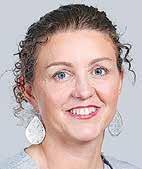
Frances Beeston grew up on dairy farms across New Zealand, developing a passion for the industry from a young age.
Throughout her career, Beeston has held various roles across the sector, including as a contract milker and equity partner. She now oversees multiple family farm businesses.
She also serves on the Rural Women New Zealand Board and is a member of the LIC Shareholder Reference Group. Beeston is passionate about mental health and wellbeing in the rural sector, working with organisations like the Rural Support Trust to provide support to farmers.
Since 2018, she has been the Mid Canterbury Rural Support Trust’s wellness and Mycoplasma bovis coordinator.
“Frances has consistently shown up for her community and the wider sector,” says Smith.
“She has a deep understanding of her ‘why’ and her people-centric passion stood out to the judges.”
Jo Sheridan

Jo Sheridan has proven to be a dedicated leader within the dairy industry, known for her passion for sustainability, education, and community engagement.
Sheridan grew up on a dairy farm in South Taranaki, developing an appreciation for agriculture which led her to earn a Bachelor of Applied Science (Honours) in Soil Science from Massey University.
She has over 24 years of experience in the industry, holding various roles at DairyNZ and serving as an independent industry consultant.
Currently, she is the demonstration manager at Owl Farm, a role she took on in 2019, oversee-
ing a 140ha dairy farm, focusing on sustainable practices, farmer education and youth engagement.
Smith says Sheridan demonstrated passion, authenticity and a strong realistic view of how she can continue to make a positive impact on the sector.
“The judges were left with a clear impression of Jo’s energy and passion for the sector,” she adds.
Lara Sutton
Herd-owning Waikato
sharemilker Lara Sutton manages 300 cows on 138 hectares while balancing her professional career and family life.
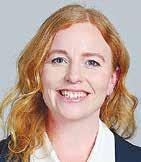
Sutton, who holds degrees in law and
accounting, is a chartered accountant and qualified solicitor in addition to her dairy sector work.
She is also strategy & commercial partnerships manager at DairyNZ.
Smith says Sutton left the judges with a clear sense of her ability to connect and lead.
“Her demonstrated
ability to continue to challenge herself has seen her seize opportunity and develop significant process and progress in the dairy industry,” she says.
Sutton is passionate about sustainable farming, mentoring young professionals and creating opportunities for those entering the industry.





CO-EXISTENCE OF genetically modified (GM) and non-GM plants in New Zealand industries will be challenging, but is achievable, a review has found.
In a recent article in the New Zealand Journal of Agricultural Research, leading researcher and chief technical officer for AgResearch subsidiary Grasslanz Technology, John Caradus, looked at the issue through a global lens to see what the experience of other nations had been.
“In the first decade of commercial GM use, there were a significant number of contamination incidents resulting from GM presence in non-GM crops and seed, some with a significant financial penalty.”
Proposed legislation in New Zealand is expected to allow greater use of GM and gene editing technology, including in plants; making co-existence critical to the needs of different industries of the primary sector. The issue was repeatedly raised in recent submissions on the Gene Technology Bill before the NZ Parliament.

“We know co-existence is achievable because several other nations have successfully managed it, including nations that are both
major producers of GM products and non-GM products, with the latter including products from the organic sector,” Caradus says.
“Organic farmers obviously have a particular
interest given GM use is regulated to be zero.
Co-existence regulations and guidance have been developed in many countries and can occur with appropriate planning and communication within
farming communities. This must be working effectively when you consider that countries with the largest areas devoted to organic agriculture also have amongst the highest land area used for
GM crops.”
Genetic modification and gene editing have enabled major gains in the performance of crops globally, and opportunities to enhance pasture plant species are now being tested.
Caradus says co-existence has been a contentious issue since GM technologies were commercially released in the 1990s. In New Zealand in 2002, a public controversy emerged over the importation of corn claimed to be contaminated with GM corn, prompting a formal probe by Parliament.
“In the first decade of commercial GM use, there were a significant number of contamination incidents resulting from GM presence in non-GM crops and seed, some with a significant financial penalty,” Cara-
dus says.
“However, these types of incidents seem to be less frequent in recent times. New Zealand needs to learn from mistakes that occurred in the first decade of GM crop use and determine effective methods for ensuring co-existence of GM, non-GM and organic farming systems.” Strategies for effective co-existence included both on-farm management decisions and downstream segregation during processing of seed in the supply chain. Coexistence on the farm was reliant on physical containment to stop pollen dispersal and seed movement, which could be assisted by using biological/molecular containment through genetic manipulation to disrupt the pollination and fertilisation process.
There’s more to feeding out these days than throwing a couple of small hay bales on the ute. Depending on their farm set up, farmers need to consider feed-out wagons, trailers, bale feeders, mobile feed troughs, cow housing, feedpads, loaders and grabs, plus the supplements and mineral additives available. Dairy News’ special report on Feeding Out will cover the hardware available as well as the best practices for maximising animal nutrition and minimising feed wastage.
To be in this special report contact your advertising representative now to promote your products and/or service to all NZ dairy farmers and sharemilkers.
FEATURE: 29 April 2025
BOOKING DEADLINE: 16 April 2025 MATERIAL REQUIRED: 22 April 2025

Connecting tech for better decisions
THE DAIRY sector is in a strong position, with high milk prices, declining interest rates, and renewed confidence.
But as history has shown, farming is cyclical. While times are good, farmers have a golden opportunity to invest in their herds – accelerating genetic gain now to build resilience for when conditions are less favourable.
With peak cow numbers reached, the next stage of dairy’s evolution must focus on maximising the performance of existing herds. Fortunately, the tools and technology available today make it easier than ever to make smarter breeding and management decisions that will drive efficiency and profitability in the long run
The power of genetic gain
One of the most significant levers for improving herd efficiency is genetic selection. CRV myHERD Testing data shows that the top 25% of cows produce, on average, 165kgMS more per season and Fonterra data shows they are over 16% more methane efficient per kgMS than the bottom 25%.
Yet, a concerning statistic DairyNZ shared with farmers at CRV’s Better Herd events in March, is that 21% of New Zealand’s replacement heifers come from the bottom quarter of the herd.
Continuing this replacement strategy, or non-strategy as it is, slows genetic progress and reduces potential profitability.
The good news is that farmers can change this trajectory. Genomic testing provides insight into an animal’s potential at just a few days old, offering the same reliability as waiting for five herd tests. This means farmers can make animal selection decisions much earlier, making sure they are only keeping and investing in their most productive animals.
The rapid advancement of farm technology is removing human variability from decision-making, allowing for more precise and efficient herd management – for example heat detection. By integrating technology like cow wearables, herd records, genomic testing, and auto-drafting systems, farmers can more easily identify their topperforming animals and ensure that replacement heifers come from the best of their genetic pool.
The improved reliability of sexed semen is also a game-changer. Farmers can now breed heifers from only their top cows while using beef genetics on lower-performing animals. This approach enhances genetic progress and supports growing industry incentives for more productive, emissions-efficient herds.
The economic case for investing
While it’s tempting to focus on immediate returns, history shows that efficiency matters most when times get tough. The difference between the top and bottom quartiles in a herd becomes even more pronounced when milk prices drop. A 165kg difference in milk solids is significant at a $10 payout, but at $5 payout, that gap becomes even more critical to maintaining profitability.
Investing in genetic gain today is an insurance policy for the future. The more efficient a herd becomes now, the better positioned farmers will be to weather fluctuations in milk prices, environmental requirements, and production costs.
Working together CRV works alongside farmers to help them make the best breeding decisions by providing the tools, insights, and expertise needed to breed a healthy and efficient herd, faster. Through initiatives like our involvement in Fonterra’s Co-operative Difference programme, we’re also making it easier for farmers to
access tools that support efficiency and sustainability on their farms.
So, as dairy farmers ease toward the finishing line of this record-breaking season, I encourage them to take the oppor-
tunity to invest in their herds now. Use the tools and technologies available to make smarter breeding decisions. Doing so will put them on the course for ensuring their herds remain competitive, pro-
ductive, and resilient for years to come.
• James Smallwood is managing director, CRV NZ
James Smallwood, CRV


•
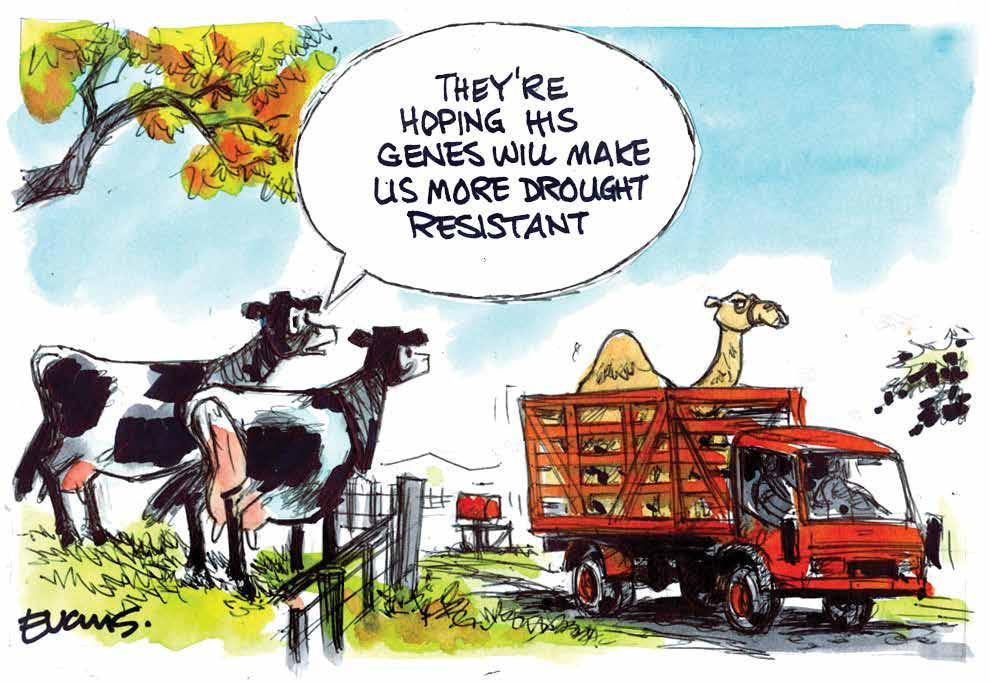

Double standards
AS SOON as RNZ realised MP Andrew Hoggard’s sister worked for Dairy Companies Association of NZ (DCANZ) and was, shock horror, lobbying government on behalf of its members, it wasted no time accusing him of not managing conflicts of interest
Contrast this with RNZ’s refusal to cover the latest Green Party scandal – MP Benjamin Doyle being asked by the Deputy PM among others to explain his use of the offensive term ‘bussy’ on his social media
Like most media, RNZ wouldn’t touch the story, until the Green’s spin was released, at which point they and all ‘legacy media’ ran the spin, minimising the severity of Doyle’s actions and attacking those asking the questions Cue yet another survey, this one showing 61% of the public believe the media is misleading them Milking It has to wonder, when will woke media start joining the dots?
pile on STAYING ON media double standards, another example of the woke media was full display last week
A National MP hosts people from a fringe religious group, which is under investigation for alleged child abuse in NZ and overseas and its frontpage news – and a media pile on begins
Ilam MP Hamish Campbell said while he’s been made aware of the historical allegations through the media, he has no personal knowledge of the individuals involved A scientist for the last 20 years, Campbell said he has an association to the group through my family
Compare this MP’s case to Green MP Benjamin Doyle’s case and you wonder why some people cannot have enough contempt for the hypocrisy of legacy media
Synlait’s back
AFTER YEARS of financial turmoil, Canterbury milk processor Synlait is now back in business
This was confirmed when the listed company proudly announced that a significant majority of the cease notices issued to the company by farmer suppliers are now withdrawn The company’s 220 farmer suppliers threatened to vote with their feet as Synlait faced financial doldrums The company says farmer support provides them with valuable certainty and reflects growing confidence in the company on the back of return to profitability
Synlait’s turnaround is reflecting on its share price: after dropping to 45c/share in January this year, it jumped to over $1 on March 20 before slipping back and settling around 75c last week
Greenpeace a charity? SHOULD GREENPEACE be stripped of their charitable status? Farmers say yes
Federated Farmers wants the Government to punish Greenpeace for their illegal occupation of Port Taranaki this month
Four Greenpeace protesters were arrested by police after they occupied a storage facility at Port Taranaki and disrupted a shipment of palm kernel destined for Fonterra farms Federated Farmers spokesperson Richard McIntyre questioned whether Greenpeace should call themselves a charity
“They’re nothing short of an extreme activist group who illegally disrupt legitimate businesses and spread dangerous misinformation ” Charitable status in New Zealand is intended to support organisations that advance public benefit through education, relief of poverty, and other recognised charitable purposes Under the Charities Act, organisations must operate for the public good and not primarily serve political or advocacy purposes
Publisher: Brian Hight Ph 09-307 0399
General Manager: Adam Fricker Ph 021-842 226
THE WORLD is bracing for a trade war between the two biggest economies.
As the threat of tit-for-tat tariffs between the US and China intensifies, New Zealand exporters watch nervously.
If the trade war were to trigger a recession in China, that would mean less buying power for Chinese consumers who love our milk, meat and fruit. And if the recession spreads to the EU and other the Middle East, our other key markets, and reduced our export returns, that would present a major economic challenge to our country. This threat comes on top of the extra 10% tariffs slapped on NZ exports to the US. How things play out remains to be seen. The only thing the NZ Government can do right now is to make their case to the US administration on why the 10% additional tariffs on goods imported from NZ should go. It’s clear that President Trump is placing every country that exports to the US on notice – he wants a balance in trade.
For the dairy sector, the 10% tariffs are disappointing as the US already had far higher tariffs on dairy products it imported compared to the tariffs New Zealand charges.
For NZ dairy exporters, navigating a quite challenging global dairy trade environment is nothing new. For now, the dairy sector, like others, can wait and see how the tariffs saga plays out. Like other countries, NZ also points out that the US is a close and valued trading partner. Both countries have been closely aligned for decades in support for better global trade rules. A comprehensive free trade agreement has been on the table to eliminate the few remaining trade barriers between the two countries.
However, President Trump is no one’s friend when it comes to trade.
Next month when Trade and Agriculture Minister Todd McClay meets his US counterpart, he’ll be putting NZ’s case, arguing that trade between the two countries is balanced and the additional tariffs aren’t necessary. Let’s hope McClay succeeds where many other global politicians have failed.
Head Office: Lower Ground Floor, 29 Northcroft St, Takapuna, Auckland 0622
Phone 09-307 0399.
Postal Address: PO Box 331100, Takapuna, Auckland 0740
by: Inkwise NZ Ltd Contacts: Editorial: sudeshk@ruralnews.co.nz
: davef@ruralnews.co.nz Rural
on-line: www.ruralnews.co.nz
: subsrndn@ruralnews.co.nz AUCKLAND SALES CONTACT: Stephen Pollard Ph 021-963 166 stephenp@ruralnews.co.nz
Editor: Sudesh Kissun Ph 021-963 177
Machinery Editor: Mark Daniel Ph 021-906 723
markd@ruralnews.co.nz
Reporters: Peter Burke Ph 021-224 2184 peterb@ruralnews.co.nz
Subscriptions: Julie Beech Ph 021-190 3144
Production: Dave Ferguson Ph 027-272 5372
Becky Williams Ph 021-100 4831
Digital Strategist: Jessica Marshall Ph 021 0232 6446
JOHN RIDDELL
THERE HAS been a bit of discussion in the media lately about the Paris climate agreement and whether New Zealand should withdraw from it. It seems to me that they are asking the wrong question. I have put a lot of time into trying to understand the climate change story and the question I think we should really be asking is, ‘should we pull out of the Paris agreement immediately, or in a few years once it collapses when people work out what is the true cost of net zero?’
The official narrative sounds just peachy. Simon Watts, our Minister of Climate Change, writes, “We are confronting climate change head-on, ensuring a cleaner, more resilient, and prosperous future where our people, economy and environment thrive”.
Isn’t that wonderful. Seriously, who could not be on board with that.
The problem is though, there are places in the world much further down the net zero road than we are, and they are starting to crash into the difference between ideology and reality. Both Germany and the UK have invested heavily in wind and solar electricity generation and their electricity is some of the most expensive in the world. It does not matter how often you say wind and solar generation is cheaper than coal and natural gas, if they really were cheaper, they would not need to be subsidised.
At least Barack Obama was honest in 2008 when he said that “under my plan, electricity rates would necessarily skyrocket”.
In the UK, these skyrocketing energy prices are starting to hurt, and people are starting to notice.
In a speech on the 18th of March 2025, Kemi Badenoch, leader of the British Conservative Party, said a few interesting things about net zero.
“Net zero by 2050 is impossible.” She
also said, “Anyone who has done any serious analysis knows it cannot be achieved without a significant drop in our living standards or worse, by bankrupting us.” And, “It’s fantasy politics. Built on nothing. Promising the earth. And costing it too”.
She is not the only one noticing. In an article on 27th March in The Telegraph by Matthew Lynn, the headline reads ‘The tide is turning against the fantasy economics that prop up net zero’.
The sub-heading said, ‘Many of the things we take for granted are about to become prohibitively expensive’. Neither Kemi Badenoch nor Matthew Lynn are climate skeptics.
The fact that in New Zealand we are even talking about withdrawal from Paris is a huge shift in the Overton window. Trump’s election and the subsequent US pulling out from the Paris agreement has really put a ferret in the chook house. We are now allowed to point out the insanity of what is being proposed.
What is being proposed is we are going to stop using abundant, cheap (because they are abundant) energy-dense fuels like oil, coal, and natural gas because they put carbon dioxide into the atmosphere.
We are not allowed to use nuclear, which doesn’t put carbon dioxide in the atmosphere, because that would solve the problem. We are instead going to try to replace that energy with intermittent low-density energy and therefore expensive to collect from wind and solar. If you think pumped hydro, hydrogen or batteries can be used to store the energy economically, you have not been paying attention.
What is proposed is replacing the 3.5 million cars in New Zealand with EVs. And we’re going to charge them with wind and solar? If a million EV owners get home from work at 6pm and plug in to a 7kW fast charger the demand would be 7000MW. As I am writing this, Transpower says total demand for the
whole of New Zealand is 4487MW. The numbers do not add up.
The idea we are transitioning away from fossil fuels is profoundly ignorant, superstitious nonsense.
Go and have a look at “Our world in data Global direct primary energy consumption”.
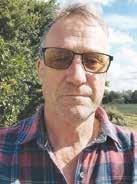
John Riddell
Oil, coal and natural gas make up more than 80% of the total energy used by humans. Nuclear and hydroelectric are about 15%. That leaves less than 5% from burning wood and dung. Oh, yes. Some of that 5% is wind and solar.
The world has spent hundreds of billions if
not trillions of dollars, pounds and Euros and yet only a tiny fraction of our energy comes from wind and solar that will need replacing after 20 to 25 years. The so-called transition is not happening.
There are people whose income depends on the net zero narrative
being believed. They are not going to be happy with what I am saying, but reality plays last. We can either pull out of the Paris agreement now or we can wait until the peasants start reaching for the pitchforks.
• John Riddell is a Waikato dairy farmer.



NEW ZEALAND feed producers are being encouraged to boost staff training to maintain efficiency and product quality.
Last year the New Zealand Feed Manufacturers Association (NZFMA) created and launched a new series of training workshops to deliver industrydeveloped qualifications.
A key element of the workshops was that they were held on actual production sites to allow training in real life situations. The goal was to uphold the FeedSafeNZ standards used in accredited sites for producing highquality feed for the animals New Zealanders consume and export.
Last year, over a million tonnes of animal stock feed was produced in New Zealand.
NZFMA executive director Michael Brooks says the workshops are just one of the ways the NZFMA helps ensure the feed production sector is as effi-
cient as possible while ensuring quality is maintained.
“The international grain market has been volatile with global events and rising costs. It’s been a tough few years for the industry, having to navigate uncertainty and adapting quickly to change, but I’m proud to say the industry is in good heart and the uptake of this training across the industry is a healthy sign of that.
“A strong programme like this benefits the whole agricultural sector and all those who purchase quality local feed for their animals.”
Brooks says 2025 spots are filling up already, but a few spaces are available.
“I’d encourage anyone in the feed manufacturing business to sign up, no matter the level of experience or size of the feed mill. This course is designed by the industry for the industry and is an invaluable part of good business practice.”

With over 20 years’ experience, industry expert and NZFMA facilitator Trevor Scoones helped lead the development of the course and has seen continued interest from the feed manufacturers he trains.
Scoones says the NZFMA Training

lyn Watson says.
THE SIX young cattle breeders participating in the inaugural Holstein Friesian NZ young breeder development programme have completed their first event of the year.
Waikato’s Sean Alexander, Canterbury’s Rachel Cox, Horowhenua’s Cara How, Otago’s Megan Morrison, Canterbury’s John Wakelin and Manawatu’s Karl Wood took part in a two-day introductory session from March 19-20 in Hamilton, which outlined how the programme would run.
This was followed by a session on understanding TOP traits and Breeding Values, along with governance training covering the four pillars of governance, director responsibilities and governance for not-for-profit organisations.
“It was great to meet the participants in the inaugural Young Breeders Development Programme, they are a great group of keen future leaders,” HFNZ general manager Cheri-
“The first sessions were well received by the group with everyone agreeing they learnt something across the two days. I Iook forward to following their progress through the programme and seeing them develop a range of skills that will allow them to contribute positively to the New Zealand dairy industry in future.”
The six young breeders were approached to join the programme, which runs from March until December, by the Holstein Friesian NZ board of directors, who recognised their potential for leadership roles in the future.
“The programme is targeted at young breeders and aims to help participants develop skills outside of the showring, particularly in the areas of governance and industry affairs,” Watson says.
“The Association sees this programme as a pathway to developing young breeders for board succession and to represent HFNZ across indus-
Workshop has been a success, with strong sign-ups to the two-day workshop.
“In its first year, all workshops filled up quickly and this year it’s about 90% full already. The response has been overwhelmingly positive. We have people from all levels join our workshops, from entry-level operators to management and engineers,” he says.
Over two days, participants get hands-on practical training, visiting farm mills, as well as theory sessions, where the group get to share knowledge with one another and form networks.
The workshop is split into three modules, where they learn about processing raw materials, pellet production, nutrition, quality management, food safety, health and safety and the industry’s quality assurance scheme FeedSafeNZ.
Having assisted in the develop-
ment of the workshop, SealesWinslow national operations manager Tyler Stuthridge is a strong supporter and has already sent several of his staff to attend.
“These workshops are of great value to our business and customers. It helps us stay on top of our game, keeping up with good health and safety practices and achieving the best possible efficiency.
“For customers that know to look for feed that carries the FeedSafeNZ accreditation mark it’s also reassurance that we are involved in training to maintain that,” Stuthridge says.
All members of the NZFMA are FeedSafeNZ accredited. They must undergo regular audits and staff training to uphold these high standards and maintain their accreditation.
The NZFMA hosts training workshops in both the North and South Island to be accessible to all members.
BUOYED BY strong forecasts for milk prices and a renewed demand for dairy assets, the South Island rural real estate market has begun the year with positive momentum, according to Colliers.
Following a challenging period off the back of the Covid-19 pandemic and rising on-farm costs, market activity has grown considerably in recent months.
With green shoots emerging at the back end of last year, that has carried through into 2025. Fonterra’s 2024/25 season forecast Farmgate Milk Price has a midpoint of $10/kgMS, providing a boost for farmers.
try affairs in the future.”
Throughout the year, participants will attend a mixture of online and in-person workshops covering industry topics such as understanding three-generation pedigree reports and bull catalogues; health, safety and risk assessment; understanding the national breeding objectives and breeding values that underpin the New Zealand dairy industry; genomics; the New Zealand milk payment system and the impact of global financial fluctuations; strategic planning; banking and finance; and communication, strategic and critical thinking skills.
The HFNZ young breeder development programme is generously sponsored by Dave Marshall of Waihou Friesians, Te Puke, who is in the process of forming an education trust for young people to ensure future leaders can develop to their full potential for the betterment of the dairy industry.
Shane O’Brien, director of rural & agribusiness at Colliers Christchurch, says purchasers have been particularly active across the Canterbury region.
“During the past couple of years farmers have worked incredibly hard to make their businesses profitable and many are looking for expansion opportunities or to extend their farming footprint, which is driving a surge in local buying interest,” O’Brien says.
“We have also seen a resurgence among equity partnerships, something that has not been present in the market for several years. Buyers are searching for well-maintained farms with good management practices and strong compliance.”
While interest rates have been dropping as the Reserve Bank cuts the official cash rate, this has had less of an impact in the rural sector compared to the residential property market, according to O’Brien.
In the 2024-25 season, 25 dairy properties have been sold in the Canterbury region, a significant increase on the previous year. This renewed demand for dairy assets has seen the Colliers Canterbury team transact a collection
of major deals to start the year, highlighted by the sale of a 179ha Tier 1 farm in Methven for $10.2 million. Another premier offering of a similar size on the outskirts of Ashburton sold for $9.7 million.
Richard O’Sullivan, director of rural & agribusiness at Colliers Christchurch, says as we head into autumn, buyers are seeking purchasing opportunities under the umbrella of an easing regulatory environment, farm cash surpluses, and strong financial backing from major lenders.
“Mid and central Canterbury have been met with the perfect storm of pent-up supply being exceeded by strong buyer demand. This has led to multiple offers being received on most properties we have sold recently,” O’Sullivan says.
“Farmer confidence levels are the highest they have been in a decade and the interest we have received in the recent properties we have taken to market underscores this. Buyers are keen to invest in farmland assets in Canterbury.”
Looking further south, Ruth Hodges, director of Colliers rural & agribusiness in Otago and Southland, says the dairy market in Southland has performed well to start the year with a key theme being a highly localised buyer pool.
“Demand remains strong and a majority of the 24 sales we have seen during the current dairy season are well-located farms that offer appealing infrastructure and production capabilities. One sale topped $50,000 per hectare, pricing not seen since the Global Financial Crisis,” Hodges says.
“Activity in the Gore and Clutha districts has been more subdued. There have been five recent sales across Gore and Clutha.”
TWO HIGH producing
Canterbury dairy farmers are moving to blended stockfeed supplements fed in-shed for a number of reasons, not the least of which is to boost protein levels, which they can’t achieve through pasture under the region’s nitrogen limit of 190kg/ha.
John Frew and Dan Mulholland both farm near Darfield on farms converted a few years ago from cereal production to dairy. Dean Weastell, J Swap Stockfoods, says both farmers have over time transitioned to buying blends, ensuring the feed they’re using has the higher protein levels their herds needed.
“Canterbury’s seasons have got later, and because of the N-cap, often the grass won’t have the protein levels when they need it,” says Weastell.
“So, the cereal guys find they need more protein around mating, for example – not just PKE (palm kernel) but also DDG, canola or soybean meal.”
John Frew, Essendon Farms, manages a 240ha effective platform with 130ha support, fully irrigated with a centre pivot plus 60ha under a Rotarainer. He runs a team of four staff – “a good crew who have been with me for over three years” –milking 840 Friesian cross cows, bred with a focus on udders and capacity. He says with high-end feeds, “you need the right cow to realise the potential”.
Frew has worked for farm owner Paul Jarman for six years and is now moving from a manager role to a 50:50 sharemilking contract, saying the support from the farm owners has been great.
The farm still grows some barley and was a traditional cereal feeding operation, largely self sufficient, using its own grain. This was John’s first season using a blend
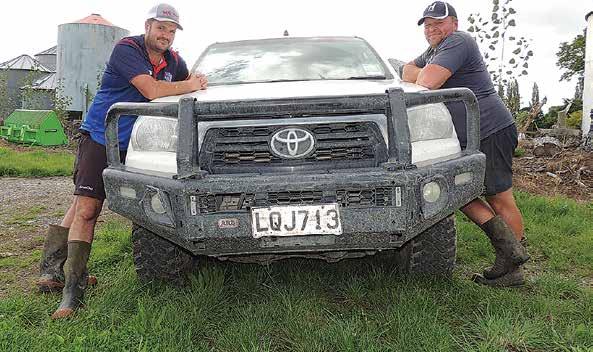
DAN MULHOLLAND and John Frew both buy ahead on a 12-month contract from J Swap Stockfoods, saying it is “always cheaper than the spot price”, and that ordering ahead helps with cashflow
“And because we don’t have to store the feed like we used to with barley, you pay as you use it, and as you get the benefit,” says Mulholland
Dean Weastell, J Swap Stockfoods, encourages customers to book a blend at the start of the season
“You need confidence the payout will support it, but it allows flexibility to change the blend as you go, to manipulate the protein: feed ratio,” says Weastell “They’ll typically chase the production, then keep condition on for mating, backing off the protein by late Jan-Feb to more of a maintenance level to reduce costs
Weastell says customers are not just buying feed from J Swap, but also servicing their animal health requirements via the mixed feeds
“Canterbury farmers tend to want to maximise production and also have us take care of the animal health additives I’ll discuss in more detail with farmers what their nutritional requirements are, not just sell them tonnage ”
Weastell operates out of J Swap Stockfoods’ store in Christchurch, selling direct to farmers in all regions of Canterbury, the West Coast and further north He says the fully integrated service they offer is a key point of difference J Swap runs its own trucks, including the ‘blower’ and augur trucks, runs double shifts and offers reliability and flexibility with delivery
and he has had good results.
“We’re still learning what blends work best but our confidence is growing, and Dean’s been good, giving us a steer on the blends and trigger points. He’s been a big help, and the pricing is always fair.
“Our protein levels dropped mid-January, so we got in a blend of 60% PKE plus 20% DDG and the rest barley – protein levels shot back up as did
milk ureas.
“There’s still a place for cereals and we still use 20% barley across a season. The mixed feeds level out your production though, so you don’t get that roller coaster effect, and the PKE is often cheaper than grass.
“We’ll also start adding minerals into the feed to help the animal health. The dosing is more accurate doing it through the in-shed feeding rather than in the
paddock.”
He says he likes the flexibility he gets using J
Swaps. “They’ve always got what you want and can deliver it when you
need it – even at short notice, if you get caught short. Service is the key really.”
Not far up the road towards Darfield township, Dan Mulholland farms 240ha of irrigated land, at peak milking 820 mixed Kiwi-cross Friesians – also running a team of four staff.
He has had his first full season of in-shed feeding, giving each cow 4kg of supplement per day until December then backing it off gradually to 2kg/cow by March.
“With the 190 N-cap (down from 260kg/ha), you can’t get enough protein in the grass early in the season when you need it,” says Mulholland.
“So, we feed them up to get a flying start in the early part of the season. Production usually drops off later in the season but it’s held better on the mixed feed. Buying the mixed feeds is the only way you can get enough protein into a 4kg ration.
“We also now get a custom blend with minerals in the feed.
“The mixes depend on the season. We can change the blend as conditions require, all at the contract price.”
Weastell says Mulholland has had very good results through spring, using a pre-mating premix with mineral pack to get production and animal health benefits.

THIS SEASON’S dry conditions have made one thing clear: not having enough feed on hand can bring your season to an early close.
I’ve been hearing from many farmers who are planning to dry off earlier than planned simply because they’ve run out of feed. That’s a tough spot to be in, especially when every extra day in milk could be adding dollars to your bottom line. With interest rates easing and a strong milk payout forecasted, now is the time to start planning how to maximise the opportunity for next season. Whether you’re looking to extend lactation, preserve body condition, or carry more feed into spring, maize silage should be part of the conversation.
When feed runs short, options get expensive

This summer, we’ve seen an increase in demand for feed across many regions, particularly in the North Island. Farmers have had to scramble for alternatives, often at short notice and higher prices. Rising costs for imported feed and ongoing volatility in pasture growth are making home-grown solutions like maize silage more attractive than ever.
Whether you’re buying it in or growing it on-farm, maize silage remains one of the most cost-effective and flex-

ible supplementary feeds in our systems. It stores well, feeds well, and can be strategically used throughout the season to support milk production.
Time to replace what you’ve used
If you’ve dipped into your silage reserves this
summer and autumn, the next step is ensuring you replace that feed next season.
If you’re growing maize silage, now’s the time to start planning:
• Select paddocks due for pasture renewal.
• Look for opportuni-
ties to use nutrients from effluent paddocks.
• Start preparing for the crop – soil testing, correcting fertility and pH.
Getting this groundwork right is essential to ensure yield targets are met and the economics
stack up.
And if you’re buying maize silage, talk to your contractor or grower sooner rather than later.
Locking in feed early not only secures supply, it can also help manage price and quantity expectations.
The benefits of maize silage in autumn and beyond
Maize silage acts as a buffer that helps you:
• Maintain milk production when pastures are struggling.
• Extend grazing rotations to protect pasture cover going into winter.
• Preserve cow body condition through late lactation, setting animals up for better production and mating outcomes.
Maize silage gives you flexibility. A well-preserved stack on-farm is like a savings account— there when you need it,
on your terms. In a year where every extra day in milk could be worth more than ever, having enough feed in reserve gives you the confidence to fill feed deficits and achieve your production goals.
So, whether you’re topping up depleted reserves or taking the opportunity to carry more feed into next season, now is the time to act.
The earlier you plan, the more options and value you unlock.
If you’d like help working through the numbers or designing a feed plan that works for your system, get in touch with me or my colleague Matt Dalley. You’ll find our contact details at pioneer.co.nz.
• Wade Bell is Genetic Technologies farm systems manager. Contact him at wbell@genetic.co.nz
TRACE ELEMENTS are the ‘invisible fence at the top of the cliff’ that can protect a dairy herd’s health and ensure cows meet their full production potential, says SealesWinslow nutrition extension specialist Simon Butler.
He says while trace elements play a vital role in herd health and production, they can be tricky to manage.
The five main trace element deficiencies identified in New Zealand pastoral systems are copper, zinc, cobalt, selenium and iodine. And the cost of not having enough of these five trace elements in the cow’s diet can be very high.
“Serious effects can include ele-
vated empty rate and/or in-calf rate, lost days in milk, impaired herd genetic improvement and reduced longevity. The serious financial impacts on productivity and profitability from these potential consequences are well documented,” says Butler.
He points out that, longer term, sub-clinical deficiencies in trace elements such as iodine, zinc and cobalt can go unnoticed. “But if these shortages become the norm in your herd, the result can be significant negative effects on energy metabolism, impacting growth and milking performance in the background,” he says.
“Therefore, the potential financial

•Ideal for Cattle Troughs •High Flow •Side/Bottom Mount
•Detach to Clean •Compact/Robust

risk of not getting your trace element balanced for your herd is worth the time and investment to get it right.”
Butler adds that trace elements can all be difficult to provide to cows solely through a pastoral diet, as their levels can vary significantly by pasture, by season and by region.
“The functions of these trace elements broadly fall into three categories - reproductive performance, energy metabolism and production, and immune support. These three drivers are key determinants of a dairy herd’s overall performance,” he says.
Identifying whether the herd is deficient in these vital elements is
not an easy task. Today’s high performance, high-BW dairy herds have set a new benchmark based on their size and performance, says Butler. There is a significant gap between traditional trace element standards, set many years ago, and the demands of our modern herd sizes and productivity levels.
“Trace element demands for modern, high performing dairy stock are now many times higher than the needs of historic New Zealand animals and production systems.
“We really need to be addressing this critical issue of trace element deficiency if we want to see our herds perform at their highest levels,” cau-


•Ideal for Small/Low Demand Troughs •Low Flow ve/Below Water Mount
•Built in Check-Valve
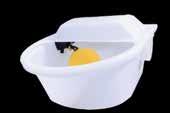
tions Butler.
He says at its simplest, identifying the levels of the trace elements in your pasture can be done through an herbage test.
“If your levels for the five key trace elements are at the lower end of medium, it’s a clear sign that pasture levels are deficient in trace elements, and your cows won’t be getting what they need.
“Herbage testing can identify particularly deficient pasture Additionally, secondary deficiencies can occur due to the presence of elements such as sulfur and molybdenum in soil, or during periods of high soil iron ingestion such as grazing winter crops.”


•Ideal for Compartment Troughs/Tanks
•High Flow
•Top Mount
•Detach to Clean
•Compact/Robust

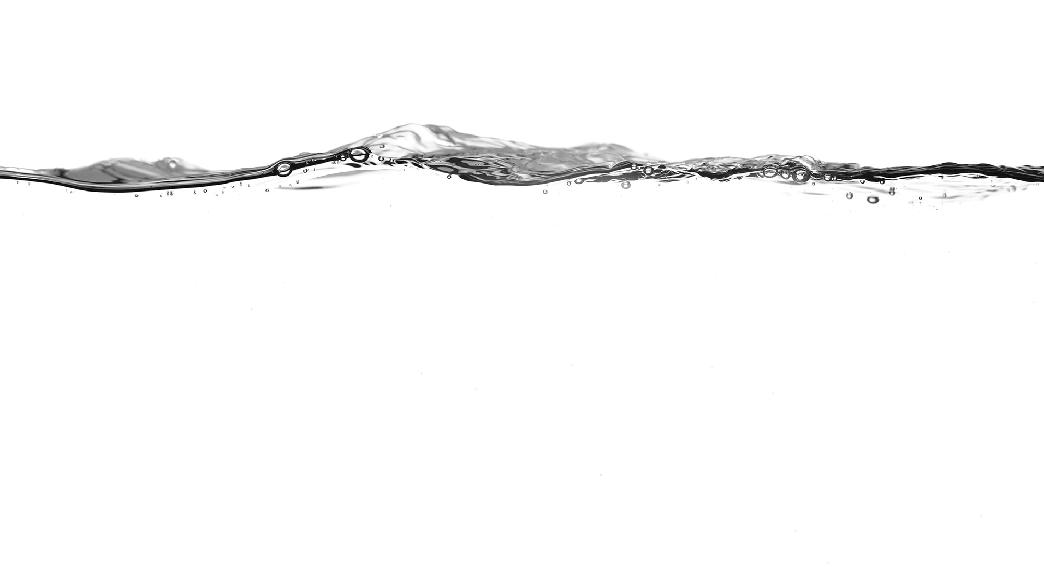

WINTERING DECISIONS
shape the success of early lactation.
Poor nutrition through winter can lead to costly problems, including slow calving recoveries, retained membranes, ketosis, and subclinical milk fever.
Balancing energy and protein
A cow’s energy and protein needs change through winter. Too little energy, and she will calve in poor condition, struggle to reach peak production, and take longer to get back in calf. Too much, and she is at risk of metabolic disorders such as ketosis and fatty liver disease.
Dry cows need a moderate-energy diet that maintains body condition without over-conditioning. If feeding fodder beet or brassicas, which are high in energy but low in protein, it is important to balance them with the right protein source, which can be based on either silage or hay, along with a well-formulated supplement. Research shows that a protein intake of around 12-14% is ideal for maintaining dry cow health and rumen function.
Cows in the early dry period can handle lower-energy diets, but in the final three weeks before calving, cows should receive gradually increased energy intake along with anionic salts so that the rumen is successfully conditioned to produce the energy required for calving and lactation. This has to be done carefully and in combination – incorrect feeding or over-feeding cows during the closeup period can lead to increased milk fever and ketosis.
Fibre and rumen health
Winter diets often differ significantly from lactation diets, making rumen adaptation critical. Sudden changes in feed type or quality can cause digestive upset, acido-

sis, and lower dry matter intake.
Cows need sufficient effective fibre to maintain a healthy rumen through winter. Feeding long-stem hay or straw alongside high-energy crops helps keep the rumen functioning properly and prevents digestive disorders. A good guideline is to ensure that at least 30% of the total dry matter intake comes from fibre sources.
For those wintering on fodder beet, keep in mind this feed is low in phosphorus and protein but high in sugar, making it easy for cows to over consume energy while missing out on essential nutrients. Slow adaptation, supplementing with phosphorus, and ensuring adequate fibre intake will reduce transition challenges.
Mineral supplementation: Preventing deficiencies and supporting calcium mobilisation
Winter diets can create hidden mineral imbalances that only become apparent at calving. Magnesium, calcium, phosphorus, and trace minerals are needed for good metabolic health, and deficiencies in these can increase the risk of milk fever, retained membranes, and poor reproductive performance later.
• Magnesium – Essential for calcium mobilisation and deficiency in winter can increase the
risk of clinical and subclinical milk fever at calving. Supplementing with magnesium chloride or magnesium sulphate is common practice in the lead up to calving.
• Calcium – While dry cows should not be overfed calcium during winter, they must be primed to mobilise calcium efficiently at calving. An acid salt supplement (negative DCAD) in the last 21 days is very important to prime cows for effective utilisation of calcium and phosphorus in the lead up to calving.
• Phosphorus – Winter crops like fodder beet are low in phosphorus. If cows are deficient, they may experience weak calving contractions, retained membranes, or poor early lactation appetite. Supplementing phosphorus is particularly important when fodder beet makes up a large portion of the diet.
• Selenium, copper, and zinc – These trace minerals play a key role in liver and immune function, leading to later reproductive success.
Feed testing and adjustments
Winter feed quality varies, and cows may not be getting the nutrients they need. Testing silage, hay, and brassica crops allows for more precise supplementation, helping to fill gaps before they cause health issues.
Forage testing can highlight energy, protein,
and mineral shortfalls so farmers can adjust supplementation early.
■ Maintain consistent dry matter intake (DMI) – Cows should be consuming roughly two percent of their liveweight of dry matter per day through winter
■ Adapt cows gradually to post-winter diets – Rumen microbes need time to adjust to new diets If cows are transitioning from fodder beet or brassicas to pasture and supplement, introducing changes over at least two weeks will prevent digestive issues
■ Avoid over-conditioning – Targeting a BCS of 5 05 5 at calving is ideal If cows gain too much weight over winter, reducing high-energy supplements while maintaining adequate protein and minerals can help keep them on track
■ Provide adequate shelter and water – Cold stress increases energy demands, while limited water intake can reduce overall feed intake
Winter prep pays off
A well-managed wintering plan makes all the difference to your transitioning cows Balancing energy and protein, maintaining rumen health, and supplementing key minerals means farmers can reduce the risk of costly metabolic problems and support better milk production and fertility

MARK DANIEL markd@ruralnews
SINCE DONALD Trump’s import tariff announcement, the world has been on a wild economic ride.
Indeed, by April 8, US companies alone had lost around US$2.5 trillion in value, only ever seen before in the Great Depression, the Global Financial Crisis and the Covid crisis – none of which were intentionally started. Of course, farm machinery manufacturers will be affected, particularly those with production sites in Europe who ship to the United States. In response to the increased tariffs
announced on April 2, JCB says it will increase the size of its new factory
that is currently being built in Texas.
“In the short term, the imposition of tariffs will have a significant impact on our business,” said Graeme Macdonald, chief executive of JCB – the UK-based construction and agricultural equipment manufacturer.
“In the medium term, our planned factory in San Antonio will help to mitigate the impact; we are thankful that the tariff is only 10%, but we hope that the UK Government will conclude negotiations on a trade deal in the coming days and weeks.”
Trump used ‘emergency powers’ to issue a 10% baseline tariff across the board on all imports to the US that took effect on April 5th. Higher tar-

iffs are set for countries with larger trade surpluses with the US, like China at 54% higher and the European Union at 20% higher. O course, the UK left the European
Union in 2020.
JCB has announced that its “original plan” to build a 46,500 square metre plant in San Antonio has now been doubled to 93,000 square
metres or 22 acres, easily making it the company’s second-largest factory.
The $500 million plant is set to begin production in 2026 and employ 1500 people, comple-
menting the company’s North America headquarters in Savannah, Georgia, where it has been for 25 years, employing about 1000 people. That 46,500 square metre facility manufactures skid steer loaders, compact track loaders and Teleskids. It also produces the High Mobility Engineer Excavator and Light Capability Rough Terrain Forklift for the US military and other NATO-aligned forces.
Elsewhere, global ag equipment company
CNH Industrial says it has temporarily paused shipments due to uncertainty stemming from the ongoing tariff situation. In a statement, the company is stopping shipments from North America plants and European imports, effective immediately. Officials say the move is temporary until they assess the full impact of tariffs on pricing. The company stated there are no impacts to production and shipment of parts will continue as planned.
“JCB has been in business for 80 years this year, so we are well accustomed to change,” said JCB chairman Sir Anthony Bamford. “The United States is the largest market for construction equipment in the world, and President Trump has galvanized us into evaluating how we can make even more products in the USA, which has been an important market for JCB since we sold our first machine there in 1964.”
SILAGE MAKING is both a science and an art, but Claas says it offers onboard technology featured in its Claas Perfect Partners to help farmers make silage more efficiently and effectively.
Firstly, ISOBUS compatibility enables seamless integration and communication between tractor and implement, which increases productivity and ease of use, says Claas.
When paired with Claas Disco mowers, the mower functions like individual lifting, side shifting or groupers in and out of work, can be configured to an ISOBUS tractors F keys allowing easy control – even while mowing is underway.
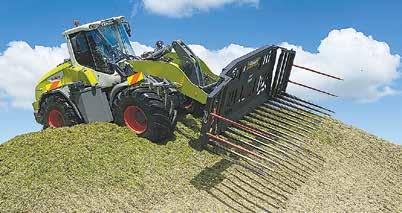
The standard Active Float mower suspension can be adjusted to suit the harvest conditions via ISOBUS while mowing is underway.
GPS Pilot Cemis 1200 is said to offer precise track guidance and numerous ISOBUS functions.
Agricultural machines can be steered efficiently using the associated terminal, allowing the exchange



of data and information with a universal language through a single control console in the tractor’s cab.
Overlaps cost time and money, but Claas says the 1200 is a way to avoid them, helping you with track planning and guidance. “With adjustable cor-
rection signals, you can achieve ultraprecise fieldwork – allowing you to work stress-free as well as saving you time and costs.”
Another silage making tool from the company is the Cemos operator assistance system for combine harvesters, forage harvesters and tractors from Claas.
The system’s software suggests the best setting values and helps the operator continually adjust the machine to the field conditions.
Cemos Auto Performance fundamentally changes harvest management for forage harvesters by maintaining a constant engine speed and adjusting the engine output and ground speed, the operator assistance system increases efficiency by up to 7% and enables a remarkable



fuel saving of 12% under partial load. Claas has also introduced an app to assist with the management of its factory-fitted forage inoculant dosing system.
The app helps the operator to determine the correct dosage settings based on crop yield, crop type, operating width, working speed, and the recommended dosage.
“This simple app avoids underdosage, which can have a significant impact on silage quality and overdosage, which leads to excess use of expensive inoculants,” says Luke Wheeler, product business manager, green harvesting.
“Once the data has been entered, the operator can implement the recommended settings using the CEBIS terminal.”
not be fighting with seed head early on around mid to late October.”
AMONG THE regular exhibitors at last month’s South Island Agricultural Field Days, the one that arguably takes the most intensive preparation every time is the PGG Wrightson Seeds site.
And the team effort paid off as PGW Wrightson bagged the Hamish Reid Memorial Award for best overall site and best large site at the event.
PGW Seeds in conjunction with PGW Rural Supplies takes the same site at Kirwee for each of the biennial events and populates it with display plots of its various lines of pasture, forage and cropping varieties.
Stu Hunter, Lincolnbased extension agronomist for PGG Wrightson Seeds, says planning the site began around August or September, with the plots cultivated and sown by the end of December.
“It was over six months ago the team started thinking about this and planning for this day. It’s quite satisfying to see it all come together.”
It has needed watering and care over the summer.
“Especially with our multi-graze options like your ryegrasses, the chicory that we have over the back corner there, and even the multi-graze brassica species, we’re needing to time the cuts so that we can have enough forage suitable for the display.
“The grasses would have been cut three to four times.”
Several new grasses on display this year included a perennial called Accrue.
“This is our new diploid and it has a late-flowering date so this will flower 22 days later than the original Nui ryegrass,” said Hunter.
“This gives you quality for longer into the season, before it starts to elongate and produce seed heads, so it’s a really good tool on farm if you want to hold that quality later into the season and
Also new to the site this year was Midway, a mid-flowering perennial ryegrass to give options for those who need an earlier flush of feed.
An example might be a sheep farmer needing high quality feed early in the season to support lactation for ewes with lambs at foot, said Hunter.
On a dairy farm it may depend on when they see a deficit.
“If they’re looking to boost autumn production, generally the later flowering ryegrasses have higher autumn dry matter production. So that would be when we’d use a late.
“Sometimes farms will have a couple of heading dates so that they get a flush at the right times of the year so that you’re not dealing with the whole farm flowering at one time and losing quality.”
Another product on display was Palliser, a new long rotation tetraploid hybrid.
“What this allows us to get is shoulder season growth over what the perennials would have.”
With a high percentage of perennial in its breeding compared to the short rotation hybrids, Hunter explained that Palliser has improved longevity, potentially “pushing the boat out” to four to five years before needing to renew the pasture.
Also on display was Pallaton Raphno forage crop, a cross between radish and kale which Hunter says provides really good grazing traits including drought and insect tolerance and a multi-grazing capability that could give as many as six grazings a year depending on management and conditions.
The display also put a lot of emphasis on PGG Wrightson Seeds’ “Programmed Approach” to pasture renewal, in which staff would sit down educating the merchant reps so they can have the dis-
cussion with their customer to plan out pasture renewal in a way that takes into account why a pasture may be in need of replacement and maps
out a programme going forward to give a good result not just at the end of the approach but throughout the renovation phase.



Digital Feed Management tool for daily use.




• Ability to split your herd into different groups and create a specific feed mix based on each feed source for each group based on their nutritional requirements.
• Visual display of remaining quantity required for each feed source, mixing order and mixing time for each feed source.
• Visual display of remaining feed mix quantity to be fed out.
• Track on farm inventory to ensure you never run out.
• Preset inventory list or tailor the list to your own feed sources.
• Easily adjust dry matter and cost for each feed source.
• Ability to run multiple reports e.g.
» Feed cost per group
» Total inventory used
» Feeding accuracy
» Feed Conversion Efficiency (FCE)
• Ability to integrate with other farm management software.
• Ability to set up user permissions and system setup for individual users eg Farm Manager, Farm Worker, Nutritionist or Vet.
